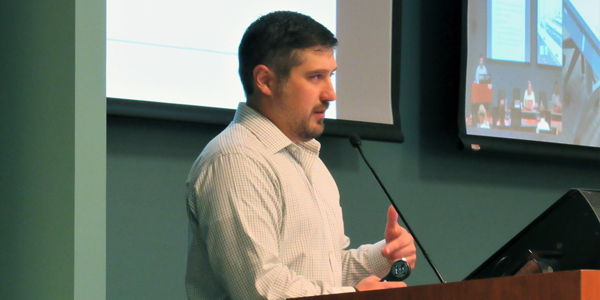By Amanda Durish Cook
MISO last week said it will revise its regional cost-sharing practices for interregional projects with SPP to match its process for PJM seams projects, lowering the voltage threshold to 100 kV and eliminating a minimum cost requirement.
The move is part of MISO’s broader plan to revise cost allocation for market efficiency projects (MEPs) as Entergy’s five-year transition period — which limits cost sharing in MISO South — expires at the end of the year. The plan still includes Tariff changes to eliminate a footprint-wide postage stamp rate for MEPs in favor of more detailed benefit metrics, and to lower the voltage threshold for cost allocation eligibility of internal MEPs from 345 kV to 230 kV.
Unlike interregional MEPs, internal MEPs will still have to meet a $5 million minimum cost threshold, although both project types will still be subject to a 1.25:1 benefit-to-cost requirement. None of the changes extends to MISO’s multi-value project category. (See MISO Recommends Cost-Sharing for Sub-345 kV Tx.)
MISO’s current regional cost-sharing rules for SPP interregional projects require at least a 345-kV voltage rating and a $5 million price tag. The new rules will mirror regional rules that FERC ordered for MISO-PJM interregional projects in 2016.
Narrowing the Cost Allocation Gap
MISO Director of Strategy Jesse Moser said that ensuring consistency along the RTO seams was the deciding factor in standardizing the treatment of SPP and PJM projects.
The current proposal will “best align who pays with who benefits,” Moser told RTO Insider.
“Our goal is to get as close to that as we can,” he said. “We’ve long had a concern about what we call the cost allocation gap on our seams.”
Having differing rules for separate RTO neighbors “leaves the door open for uncertainty,” Moser said. “We prefer a clear rule set for any beneficial project that comes out of the” interregional process.
MISO will spend the next two months preparing its overall cost allocation proposal for a FERC filing by the end of September. The RTO is open to holding a summer conference call that would invite stakeholders to offer minor suggestions for clarity, but it does not intend to open the proposal to any substantive change, Moser said.
MISO staff have spoken to SPP officials about the changes, which will not require a revision to the RTOs’ joint operating agreement because they only involve MISO’s regional cost sharing, Moser said. Meanwhile, the RTOs will work this summer on a proposal to similarly relax interregional project criteria in the JOA, which still mandates 345-kV and $5 million minimums. (See MISO, SPP Look to Ease Interregional Project Criteria.)
Moser said there was a “possibility” that FERC could have ordered MISO to lower the SPP thresholds as it did with PJM projects, if the commission had received a complaint.
“Looking at the direction we’ve seen so far, on the PJM seam, that seems like something FERC would support,” Moser said. “We have a pretty firm belief that if this issue was not addressed, it would get put in front of FERC.”
But Moser reiterated that consistency, not the threat of a FERC complaint, drove MISO’s decision.
Transmission Owners: Equal Treatment Unnecessary
But some stakeholders continue to question what would be a discrepancy between the voltage thresholds for MISO MEP projects and interregional projects with SPP. (See MISO Cost Allocation Plan Hits Interregional Differences.)
More than 20 MISO transmission owners joined in written opposition to the 100-kV threshold on interregional projects with SPP. They contend that there are differences between the PJM and SPP seams and that the two “should not receive equal treatment.”
MISO’s seam with SPP is longer and has lower load density than that with PJM, meaning generation can be situated far from load, the TOs have pointed out. Higher-voltage interregional projects are a better fit for those conditions, unlike the MISO-PJM seam where population density makes smaller transmission projects more worthwhile, they argue.
The TOs also note that MISO and PJM have been coordinating along their seam for about 18 years while the relationship with SPP is “less mature,” evolving as SPP integrated the Western Area Power Administration and Basin Electric Power Cooperative transmission systems in late 2015 and MISO integrated its MISO South region in 2013. “Congestion patterns along that seam are not well understood and are subject to change,” the TOs said.
But while acknowledging that the proposal wasn’t “universally liked,” Moser contends that MISO collected sufficient stakeholder feedback on regional cost allocation to move ahead with the plan.
“This has been a fairly long process. We’ve been working on this since 2015. We’re looking at what the new needs might be given our new footprint. … We think we’re putting together a package of reforms that best meets the needs of our footprint,” Moser said.
MISO also plans to conduct a general review of its overall cost allocation design three years after implementation, Moser said. The RTO will examine whether projects built under the new rules have benefits commensurate with cost allocation and examine any past proposed projects that appeared highly beneficial but still couldn’t qualify for cost allocation.
“There’s an understanding that needs will continue to change,” Moser said.
New Local Economic Project Type
MISO last week announced another new wrinkle for its cost allocation plan: a new project type that will be ineligible for regional cost sharing for the sake of clarity.
Moser said the new category, “Local Economic Projects,” is meant for projects that demonstrate at least a 1.25:1 economic benefit but are below 230 kV. Such projects would have their costs allocated 100% to their local transmission pricing zone. Currently, these projects fall under an “other” category.
Moser said the category is needed to distinguish small economic transmission projects from small reliability-driven transmission projects. Today, most of MISO’s “other” category of projects are reliability-driven, with few small projects being built for economic reasons, he said.






